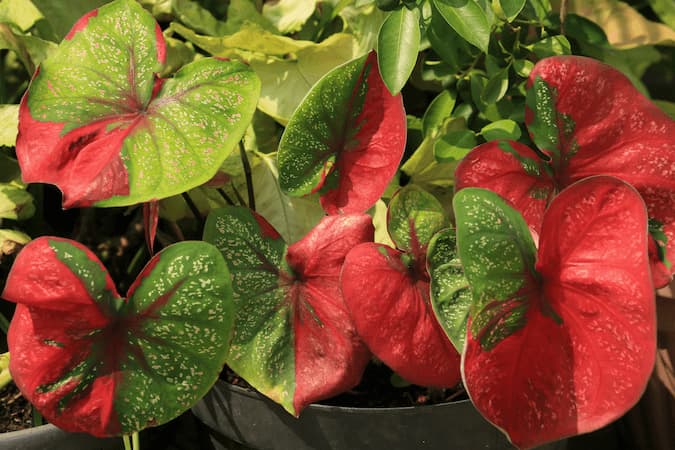How to Grow and Care for Caladium Flowers

About Growing Caladium Plants in Your Home Flower Garden
Some people know Caladium plants as a houseplant. Others recognize them as a colorful, leafy plant that brightens up the shady areas of their yard. Yet, few people are growing Caladiums for their flowers. However, the plants produce Caladium flowers that bloom in the summer. These plants are popular among home gardeners indoors and out.
Growing Caladium plants is easy. They are tropical plants, native to the Amazon River area of Brazil. So, it’s no surprise that these plants love a warm, shady, humid environment. Caladium is grown as an ornamental plant for its colorful leaves. The leaves come in a variety of combinations of green, white, pink, or red. It grows to its full height of 12″ to 30″ in one season. Caladium is perfectly comfortable in a pot or container, resulting in a very popular houseplant or deck plant.
Did you know? While it is native to Brazil, Lake Placid, Florida claims to be the Caladium capital of the world. Nurseries in this area grow a wide range of Caladiums on thousands of acres. They provide the marketplace with a choice of colorful leaved plants for you to choose from.
Poisonous Plant: All parts of the plants are toxic. See Poisonous Flowers
Flowers Bloom: Summer
Flower Colors: While Caladium plants are grown for their attractive foliage, they do produce flowers. Colors include green, pink, red, and white.
Plant height: 12 to 30 inches tall, depending upon variety.
Plant Hardiness Zones: 9 – 11
Perennial, Tacca Chantrieri
Today’s Deep Garden Thought: By the time you find greener pastures, you can’t climb over the fence.
Caladium Flower Plant Propagation
While people talk about Caladium “bulbs”, they are actually grown from a tuberous root. Plant new tuberous roots in the spring, 1.5 to 2 inches deep. The eyes should point up. They can also be grown from seeds. However, it will take much longer for the seeds to grow into a big plant. And, the plant might not bloom until later years. Also, keep in mind that the flowers are not self-pollinating. You may need to hand-polinate them.
In colder climates, it is important to bring the roots up and store them indoors over winter. Dig up the tuberous roots, Next, clean and separate them. Make sure to have some buds, called “eyes”, on each divided section of the root. Then, store the roots in dry soil, or sphagnum moss in a dry, dark location until you are ready to plant them next spring. Storage temperatures should be at least 40 degrees.
The largest tubers will produce the largest plants. Many people prefer to start with new roots each year. Many home gardeners find the roots produced by their plants are smaller and turn to commercial growers who know how to produce the biggest roots for the best plants.
Tuberous Root Planting Depth: 1.5 to 2 inches deep.
Ideal Plant Spacing: 8 to 14 inches apart.
How to Grow Caladium Plants
Grow Caladium plants in indirect sunlight to partial shade. Bright, direct sunlight can scorch the leaves. Their colorful leaves make them a great addition to your shade garden.
It’s best to give your Caladium plants a head start. Roots can be started indoors 6 weeks before the last frost date. But DO NOT transplant them outdoors before the last frost date in your area. Frost will kill them. We recommend starting the plants in individual containers. 4″ to 6″ peat pots work well for transplanting later, with minimal transplant shock.
Plant roots in rich starter soil, peat moss, or vermiculite. Roots should have a few buds on them. Water well the first time, then keep the soil moist. The plant needs warm soil to sprout.
If planting as an indoor houseplant, plant roots directly into the container they will grow in.
The plants are susceptible to drafts and sudden temperature drops.
Tip: To promote more leaves, remove the largest bud in the center of the root.
Being native to the tropics, Caladium does not like cold weather. Wait to transplant them outdoors until all danger of frost has passed, and the soil has warmed.
Select a location that is shady or does not receive direct sunlight. Caladium likes rich soil. The soil needs to be kept moist but should be well-draining. If the soil is poor, add generous amounts of compost and manure.
Caladium grows well with little care or attention. Fertilize outdoors once a month with a general-purpose fertilizer. Indoors, use a liquid fertilizer every couple of weeks. During the growing period, remove any dead or damaged leaves.
In the fall, dig up the roots for storage. The roots will survive over-wintering outdoors only in the warmest areas of the country.
Ideal Soil pH: 5.5 – 6.2
Caladium Flowers
Most people have never seen the flowers of this plant. It’s not why we grow Caladiums. Rather, we grow them for their beautiful and colorful leaves. As a result, many growers remove the flower blooms. If that’s you, remove the flower blooms as soon as you see them emerging. This allows the plant to direct more energy to the development and health of the leaves. Remove the flower stem where it meets the plant.
Insects and Plant Disease
You should experience a few insect problems with your Caladium plants.
However, it is important to remember that the best defense against plant insect problems and disease is a healthy plant. Then if a problem occurs, the plant is better able to overcome any problems that arise.
Related Articles
Also, people who read this article will like:
More on Growing Flower Bulbs, Rhizomes and Roots
Flower Gallery – Find pictures of your favorite flowers.
Please support our site. Shop for:
- rmmatthews100@hotmail.com
- 585-721-6528
- Rochester, NY
©1999-2024 GardenersNet.Com, All Rights Reserved

